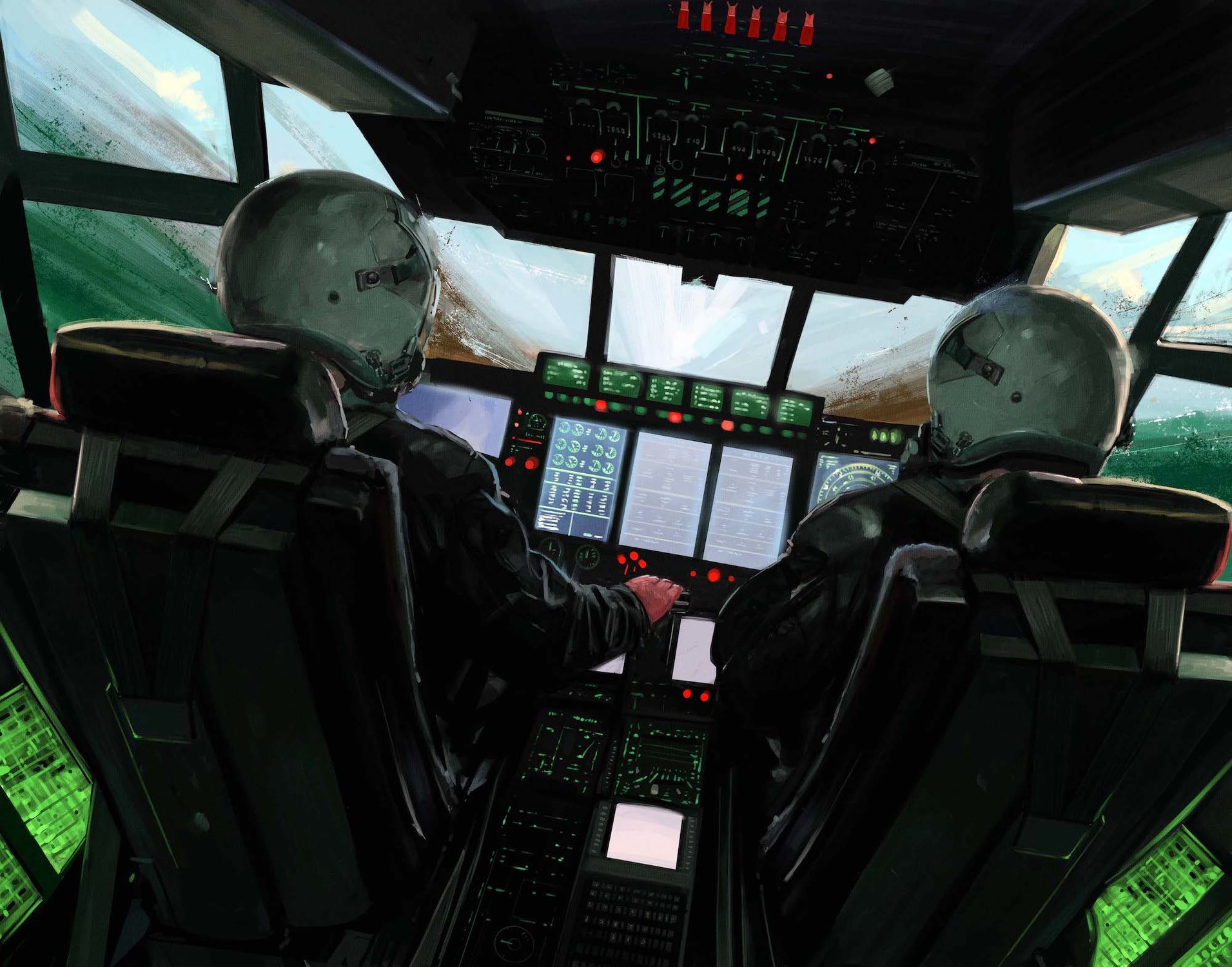
Illustration by Noah Regan.
Raider Five Zero on Fire: An Impossible Story of Survival 2 Miles High
THE AIR WAS 105 DEGREES, but the dirt field had been watered earlier that day, leaving a soft layer of mud rather than choking dust. The desert wind blew steady, hair-dryer hot, as an old sedan approached the eight Marines wearing flight suits and survival vests.
In the center of the field, a cauliflower patch plowed down to brown dirt, sat the cracked and still creaking remains of a KC-130J Hercules tanker, its nose and belly buried in the dirt, its wings torn, its engines shredded — all that was left of a flight that would be known across the flying world within hours as Raider 50, or, in aviation-speak, “Raider Five Zero.”
The Marines waved at the car, the first they’d seen since “landing” in the field. In the sedan were two men — farmworkers, figured Maj. Corey Jones, one of Raider 50’s pilots.
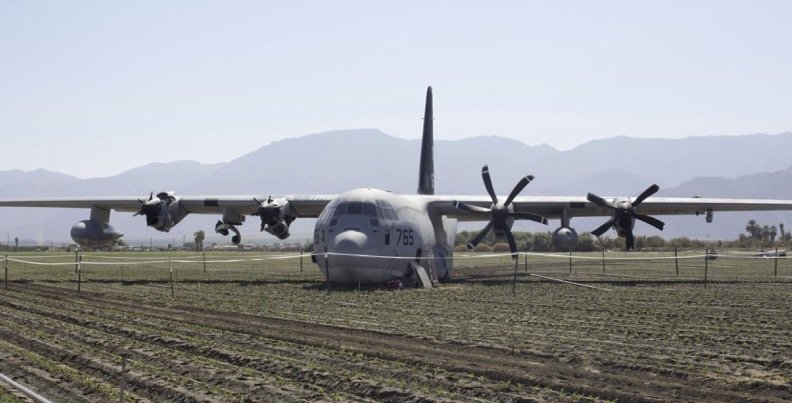
After a midair collision, Marine Corps pilots Maj. Corey Jones and then-Capt. Michael Wolff flew the stricken KC-130J for 13 minutes, ending in a wheels-up landing in a farm field in central California. The collision with an F-35 sheered off all 12 propellers on the right-side engines and the right fuel tank, and severely damaged the landing gear. Damage on the left wing, which ripped off the left refueling pod and broke several propellers, occurred during the landing as the plane skidded across the field. Fuel poured out of the plane’s wings for hours afterward. Photo from Marine Corps final accident report.
“They were just passing through — they didn’t come over to help us,” recalled Jones. One man rolled down a window and nodded toward the wrecked airplane, still belching fuel over the last whines of its engines.
A man inside the car asked, “Did you guys mean to do that?”
It was a hell of a question. Just 20 minutes earlier, Jones had been at the controls of Raider 50 as it refueled two Marine F-35 Lightnings, call signs Bolt 93 and Bolt 94. But in a moment of lost orientation, the pilot of Bolt 93 had smashed into the KC-130’s right wing, destroying his jet and crippling Raider 50 far beyond repair or recovery. For the next 13 minutes, Jones and then-Capt. Michael Wolff — Raider 50’s pilots — had coaxed, begged, and battled the dying tanker through an emergency descent and crash landing that ended with all eight Marines on board standing alone in the dry desert wind.
Both Wolff and Jones would be awarded the Distinguished Flying Cross for their skill and the cascade of life-or-death decisions made in the descent. An otherwise emotionless Marine Corps crash report — 30 pages long with 330 pages of exhibits, which Coffee or Die Magazine obtained through a Freedom of Information Act request — called the event a “fatal mishap but for the heroic actions of the Raider 50 pilots and crew.” The flight would reach viral fame, as an emergency transmission made by Wolff was captured by air traffic control trackers and posted on YouTube within hours of the crash.
And in the end, all eight of Raider 50’s crew had walked away unscathed.
But did they mean to do that? What did that even mean?
RAIDER 50 ROSE OFF THE RUNWAY at Marine Corps Air Station Miramar, near San Diego, for what would be its final flight Sept. 29, 2020, at about 1 p.m. California time. At the controls were Wolff and Jones with a flight engineer and five loadmasters on board. All were assigned to Marine Aerial Refueler Transport Squadron 352, or VMGR-352, a squadron known since 1942 as the Raiders. Raider 50 was a KC-130J, or “J-model,” tail No. 166765 — a 15-year-old plane with 8,816 flight hours, in the prime of a C-130’s long expected flying life.
The crew flew northeast from San Diego toward the Kane West Military Operating Area, or MOA, a 611-square-mile range of open desert roughly halfway to Nevada, split by a 35-mile-long shallow salty lake called the Salton Sea.
Raider 50’s mission in the MOA was to fuel up Bolt 93 and Bolt 94 as part of their pilots’ training in the USMC’s Weapons and Tactics Instructor course, or WTI, at Yuma MCAS, about 100 miles to the southeast. WTI is the Marines’ top course for relatively senior fighter pilots, a rough equivalent to the Air Force’s Weapons School and the Navy’s Top Gun.
“It was about as vanilla a flight as it gets.”
— Maj. Corey Jones
The air between San Diego and Yuma was full of Marine aircraft, with F/A-18s, AV-8 Harriers, MV-22 Ospreys, KC-130 tankers from Texas and North Carolina, helicopters, and MQ-9 Reaper and MQ-21 Blackjack drones working the desert ranges.
Raider 50’s afternoon mission was to refuel four F-35s.
“So we were pretty heavy taking off with a maximum fuel load,” said Jones. Soon after takeoff, two of the fighters canceled.
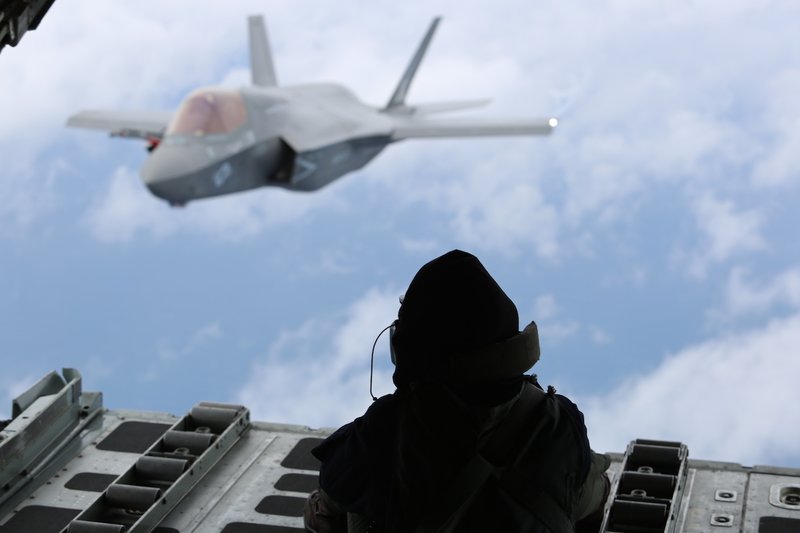
US Marine Corps Staff Sgt. Arnold Sosa, a KC-130 loadmaster assigned to Marine Aerial Refueler Transport Squadron 252, watches as an F-35B Lightning II Joint Strike Fighter performs an aerial exercise in Beaufort, South Carolina, March 19, 2015. US Marine Corps photo by Lance Cpl. Olivia G. Ortiz.
Jones and Wolff were both experienced pilots, Jones with nearly 2,000 flight hours, Wolff nearing 1,000. Wolff was a senior command pilot, and Jones an instructor, a slightly higher rating. But Jones’ wife, Lori, had just given birth to their first child and he had not flown in 55 days, lapsing some of his flight qualifications. Only Wolff could “sign for the aircraft” as the aircraft commander with Jones as co-pilot. To get his training logs up to date, Jones would do most of the actual flying, with his hands on the controls as Wolff worked the radios, kept his eyes on navigation, and oversaw the “big picture.”
The story was similar in the cargo bay, with extra crew members along to keep their qualifications up to date. Air-to-air refueling requires three loadmasters — two to observe out a window on each side, one to run the fuel pumps — but Raider 50 had six enlisted crew on board, from a gunnery sergeant at flight engineer to a corporal at loadmaster.
Nothing about the daytime flight, the crew makeup, or their flight logs was out of the ordinary. “It was,” Jones said, “about as vanilla a flight as it gets.”
JONES GREW UP IN CORNELIUS, North Carolina, and after graduating from East Carolina University took a job as a strength and conditioning coach at Iowa State.
“I realized I didn’t like the hours and didn’t like the pay, so I decided to do something with equally long hours and relatively equal pay in joining the Marine Corps,” he said.
At 26, 10 months before he would age out of eligibility for flight school, he joined the Marines, with his eyes on flying C-130s. “It seemed like a really cool platform and I liked the idea of being able to get out of the seat and go to the bathroom,” he said. “So it was Hercs or bust.”
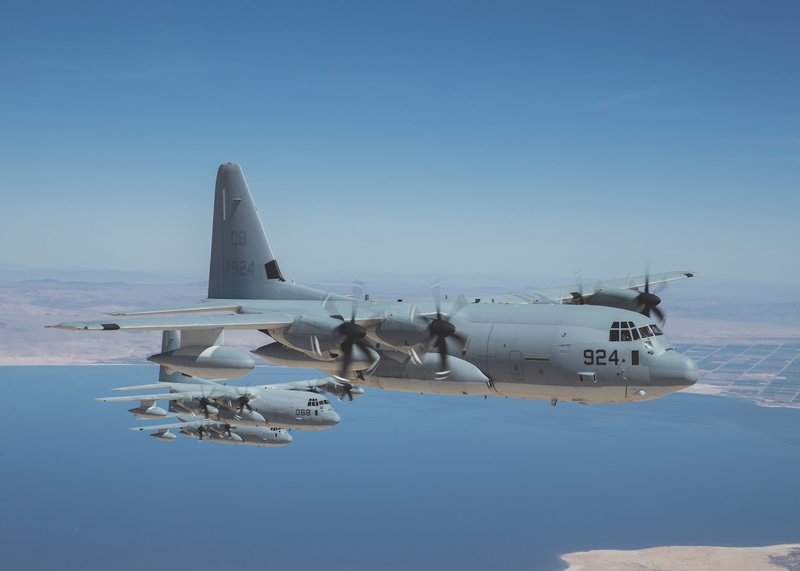
Three KC-130J Super Hercules tanker aircraft with Marine Aerial Refueler Transport Squadron 352, Marine Aircraft Group 11, 3rd Marine Aircraft Wing, conduct a ceremonial formation flight for the squadron's 75th anniversary at Marine Corps Air Station Miramar, California, March 30, 2018. US Marine Corps photo by Lance Cpl. Clare J. McIntire.
As he moved through early assignments at Cherry Point and Miramar, he was drawn toward work as a squadron safety officer, becoming an expert on investigations of major accidents across the Navy, Marine, and Air Force-wide C-130 flying world. He’d studied closely a 2018 report on the crash of a Puerto Rico Air National Guard C-130, which detailed an insidious trick a wounded C-130 can play that could fool a pilot into a fatal mistake. The error surfaces in an already-grim circumstance: when engines on one side of the four-engine C-130 have stopped, and the plane slows to what pilots call minimum controllable airspeed. That’s the absolute slowest speed that allows a plane’s wings to respond to a pilot’s inputs.
Understandably, a pilot who drops below minimum controllable airspeed will want to hit the gas, adding power to the engines. But if the engines on one side of a plane are off, adding power to the healthy engines can result in “asymmetric thrust” — too much power on one side. The plane can start to rotate, or yaw, and enter a fatal spin.
“And that would be your initial reaction, right?” said Jones. “In a stall, ‘I need to add more power.’ But if they had reduced the power instead of trying to keep the power up, you can probably actually control it.”
Asymmetric thrust had sent the Puerto Rican C-130 into a spin, Jones said, killing the whole crew.
ALL WAS NORMAL as Raider 50 flew north up the Kane West MOA, at 17,000 feet, just over the Salton Sea, on a course known as the Glamis High Tanker Track.
“It was a beautiful southern California day, not a cloud in the sky,” said Jones. “It was a good day.”

A US Marine Corps F-35B Lightning II Joint Strike Fighter performs maneuvers during an aerial exercise. US Marine Corps photo by Lance Cpl. Olivia G. Ortiz.
At 3:48, a call came over the radio: “Raider, Bolt Nine Three with you, radar 20 miles to the north, 16,000.”
The F-35s — Bolt 93 and 94 — were 20 miles away at 16,000 feet. The pilot of Bolt 93, a major who had been in the Marines since 2009, was a WTI student. He had flown almost 600 hours in the AV-8B Harrier before switching to the F-35, in which he’d flown 269 hours. Bolt 94’s pilot was a WTI instructor, with over 1,000 hours in F/A-18s and F-35s. That day’s mission was to practice close air support with on-the-ground terminal air controllers in the Chocolate Mountain Aerial Gunnery Range, before joining Raider 50 on the Glamis track.
Over the next few minutes, a series of small technical issues and bad luck would build up until they distracted the pilot of Bolt 93 at a critical moment — just long enough for him to crash the $108 million jet into Raider 50 at 230 knots.
The first of those issues came as the jets approached. Raider 50’s crew found the right-side refueling hose would not activate, with no obvious fix. They would have to refuel both jets with the left-side hose, one at a time, which made things trickier for the fighters. Before taking off, the Bolt pilots calculated a “bingo fuel” level — the absolute minimum amount of fuel necessary to return safely home. Bingo fuel is perhaps the most unbreakable of all aviation rules. No matter what a pilot is doing — even in combat — if a plane’s gas tanks hit bingo, they have to stop and head home.
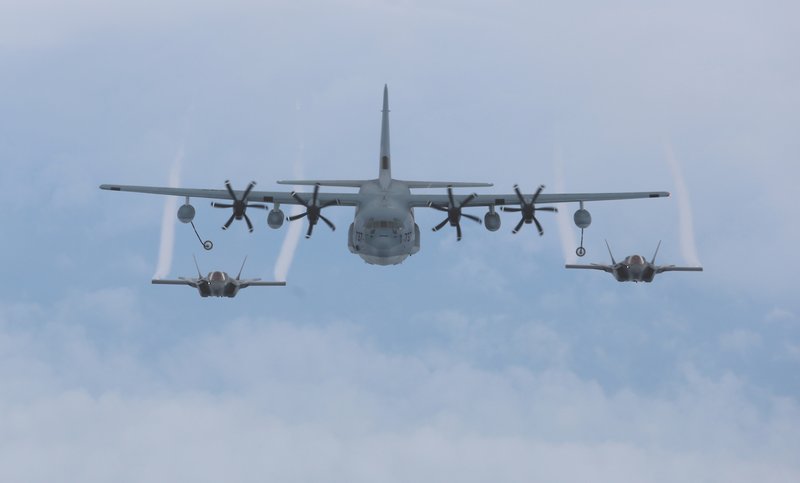
A Marine Corps KC-130J during an air-to-air refueling of two F-35B Lightning IIs. To receive fuel, the fighters connect to the hoses reeled out behind each wing. US Marine Corps photo by Lance Cpl. Olivia G. Ortiz.
The Bolts had pegged their bingo on the Glamis track at 3,500 pounds of fuel — or “3.5” — a level that Bolt 93’s pilot would later tell investigators he believed was “conservative.” But both jets arrived low on fuel, Bolt 94 at 4.6, Bolt 93 at 3.9, just minutes from bingo.
Cleared in by loadmasters watching from Raider 50’s rear, Bolt 93 swooped to the left side of Raider 50 and connected for fuel, taking on gas for an uneventful seven minutes. At 58 seconds past four o’clock, the pilot of Bolt 94 called “3.9” over the radio, his fuel level. Four minutes from bingo. Time to switch.
Bolt 93 pulled away, switching to the tanker’s right side to wait as Bolt 94 started to move in at 4:01.
But the formation had reached the north end of the Glamis track and needed to run back south. At 4:02, Jones put Raider 50 into a 20-degree left bank, which the F-35s mirrored. Bolt 94 waited for Raider 50 to stabilize in the turn, then connected at 4:03, getting a green fuel light in the cockpit.
The light went out 21 seconds later. The hose would need to be reset.
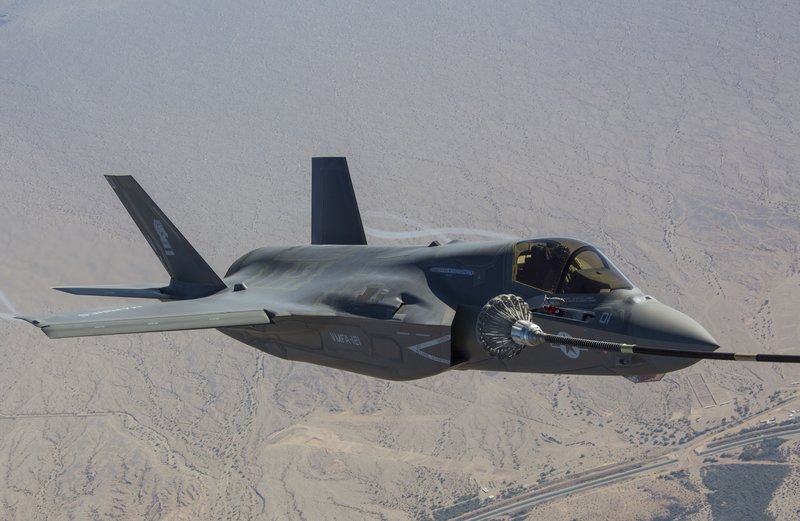
An F-35B Lightning II Joint Strike Fighter refuels from a KC-130J Super Hercules with Marine Aerial Refueler Transport Squadron 352 during a fixed-wing aerial refueling training exercise over eastern California, Aug. 27, 2013. US Marine Corps photo by Lance Cpl. Raquel Barraza.
Bolt 94 asked his wingman, just how much fuel did they really need to get back to Yuma? Could they afford to wait?
The pilot of Bolt 93 replied, “Yeah, stand by.” He later told investigators he then went “heads down,” checking bingo math and distances on a kneeboard as the formation continued the slow turn back to the south.
But that turn was now complete. Just as the pilot of Bolt 93 went “heads down,” Jones began to roll Raider 50 onto a straight heading. There is no rule in Marine aviation that requires tanker pilots to announce turns. In combat, air refueling is often done with no radio chatter at all. As Raider 50 leveled out, Bolt 93 stayed in a 17-degree left turn — directly toward Raider 50.
A loadmaster called out on the tanker’s intercom: “Nine Three’s coming in fast!” He turned away to shelter from the impact when the jet was about 10 feet from his window.
The fighter tore into both of the tanker’s engines, shattering the propellers. The doomed jet twisted into the side of the tanker’s fuselage, tearing a gash through the plane’s landing gear compartment.
At 4:03 and 55 seconds, the pilot of Bolt 94 realized a disaster was unfolding with Bolt 93 in an “uncontrolled vector” toward the tanker. He called out helplessly, “Easy, easy, easy, PUSH OVER, PUSH OVER, PUSH OVER!” — an instruction equivalent to “Dive!”
Inside Raider 50, the loadmaster on the right side simply yelled into the intercom: “Oh shit, oh shit, oh shit!”
At 4:03:57, 13 seconds after Bolt 93’s pilot went “heads down,” the F-35’s nose slammed into the bottom of Raider 50’s right wing at 16,920 feet and 264 mph. The fighter tore into both of the tanker’s engines, shattering the propellers. It also ripped loose the hose pod, causing a torrent of fuel to begin spraying out. Finally, the doomed jet twisted into the side of the tanker’s fuselage, tearing a gash through the plane’s landing gear compartment.
In Bolt 94, the pilot watched a momentary fireball engulf the F-35 and most of Raider 50’s right wing. When it cleared, Bolt 93 was gone, tumbling away. In the next minute, the pilot of Bolt 94 called out three times for his wingman to eject. He got no response.
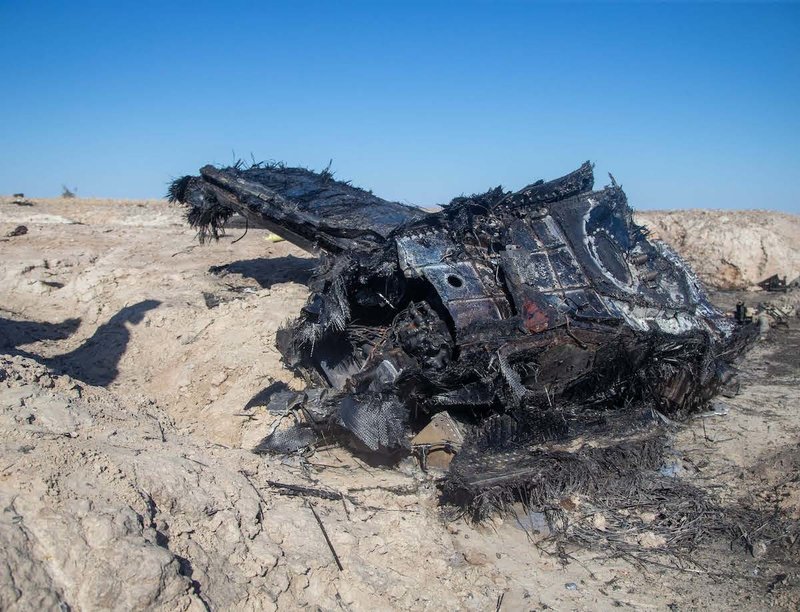
Wreckage from a USMC F-35 that tumbled out of the sky after a midair collision with Raider 50. The pilot safely ejected. US Marine Corps photo.
IT’S HARD TO COMPREHEND everything that happened and the speed at which it happened,” said Jones. “I just remember, as soon as we got the impact, you know, looking up and everything in the cockpit is super loud. Because we had a rapid decompression, it was a lot of wind noise. All the master cautions were going on.”
The collision knocked off headsets and threw bodies across the plane. As the crew struggled to regain their balance, they had to race to snap on oxygen masks or grab oxygen bottles before they passed out in the thin, high-altitude air.
In the initial seconds, Jones’ mind flashed to a doomed aircrew he’d read about but also knew personally as friends whose C-130 had disintegrated at high altitude over Mississippi in 2017.
“The entire crew perished,” he said. “I often thought, like, what were those guys feeling inside that airplane that’s just going to the ground and there’s nothing you can do. And, well, now I know how they feel.”
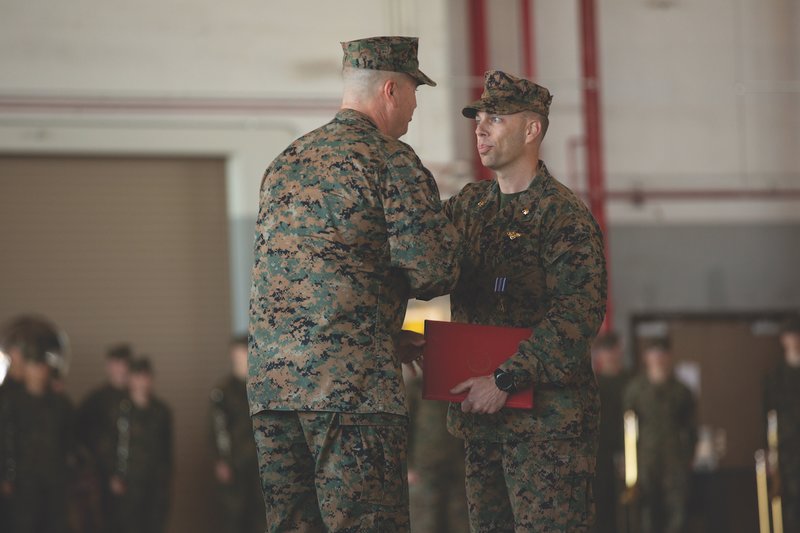
US Marine Corps Maj. Corey Jones, right, shakes hands with Maj. Gen. Michael Cederholm at Marine Corps Air Station Cherry Point, North Carolina, Feb. 28, 2022. Jones was awarded the Distinguished Flying Cross for conducting an emergency landing after another aircraft collided with his KC-130J Super Hercules. His piloting skills and timely decisions during the most critical moments of the 12 minutes from midair impact to landing are the reasons the entire aircrew were able to walk off the aircraft and are alive today. US Marine Corps photo by Sgt. Servante R. Coba.
Jones grabbed the yoke and, to his astonishment, felt Raider 50 respond to his controls. “The plane’s actually flying. That was actually pretty shocking to be quite honest,” he said. “We’re not descending, we’re not in an uncontrolled turn. I was able to keep the right wing up and the plane reacted to all my input. So, I mean, I think that’s the easiest way to say it, we were still flying.” But across the KC-130’s displays, he added, “it’s just red and yellow words.”
“We’ve lost engine three and engine four,” said Wolff, as a loadmaster called out that fuel was spraying out of the wing, with signs of fire.
“In my mind, you know, if the fire persists, we’ve got a maximum of 60 seconds before the wing separates from the aircraft,” Jones said. Another standard procedure in an emergency is to dump excess fuel, reducing weight and the hazard of fire in a hard landing. “Okay, well, we have a wing fire. We’re not gonna spray fuel. So whatever fuel was on the plane was on the plane.” Within a minute of impact, the flames on the wing had disappeared.
To land, the pilots considered a Navy field at El Centro, about 50 miles south, but realized they were just minutes from Jacqueline Cochrane Regional Airport at Thermal, California, a sleepy desert town known mostly for its proximity to the annual Coachella music festival.
With the plane still flying and a landing spot picked out, Wolff keyed the transmit button.
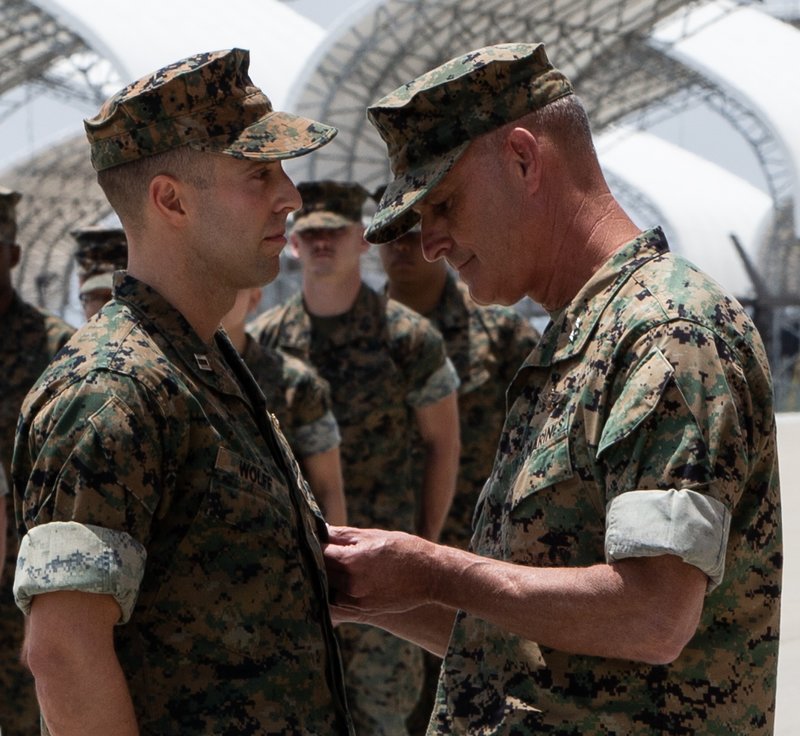
Capt. Michael Wolff, a KC-130J Super Hercules pilot with Marine Aerial Refueler Transport Squadron 352, Marine Aircraft Group 11, 3rd Marine Aircraft Wing, receives the Distinguished Flying Cross from Maj. Gen. Bradford J. Gering at Marine Corps Air Station Miramar, California, May 25, 2022. US Marine Corps photo by Cpl. Rachaelanne Woodward.
THE FAA’S LOS ANGELES Air Route Traffic Control Center — “LA Center” to pilots around the world — isn’t in LA. The air traffic control hub sits inside a squat building in the high desert city of Palmdale, not far from Edwards Air Force Base. Controllers at LA Center watch over 2.3 million flights every year as they move around America’s southwestern corner, an area covering parts of four states.
Just after 4 p.m., Wolff’s voice arrived in their headsets.
By any aviation standard, Wolff’s transmission was impossibly dire, a description not of a plane having in-flight trouble but of one actively crashing. It was also a near-perfect example of a revered pilot skill: the “cool radio voice,” an ability to calmly speak the unthinkable with clipped authority and ruthless brevity.
“Mike’s a very cool, calm, collected guy,” Jones said. “Like ‘Okay, yeah we’re about to die, but here’s our situation, LA.’ ”
“LA Center, LA Center, Raider Five Zero declaring an in-flight emergency, midair collision with Bolt Nine Three. We have two engines out, we’re leaking fuel, and might be on fire, emergency descent at this time. Raider Five Zero.”
— Capt. Michael Wolff
Wolff’s voice was an instant sensation in the SoundCloud and YouTube community that monitor and share recordings of air traffic control radio traffic. The transmission was so quickly on social media that the crew found it and played it on a phone on the van ride back to Miramar that night.
The cool Marine captain may have even lulled the controllers in Palmdale, who offered to dictate the number for Thermal’s control tower.
Jones smiles, recalling the disconnect. “Okay, nope,” he said. “Definitely not writing down a phone number right now.”

Capt. Michael Wolff, the aircraft commander of Raider 50, addresses Marines after receiving the Distinguished Flying Cross at Marine Corps Air Station Miramar, California, May 25, 2022. US Marine Corps photo by Cpl. Rachaelanne Woodward.
SOON AFTER THE PLANE passed below 10,000 feet, a loadmaster called over the intercom: “We do not have an aft-right main landing gear.”
It was, Jones noted dryly, “the second time in the flight I’ve heard part of the airplane is gone.” But even without wheels, it was beginning to look like they would at least get to a runway, with the inboard No. 2 engine at full throttle and the outboard No. 1 at about 70%.
“Everyone strapped in?” Wolff asked. The crew responded that they were, and Wolff keyed the radio mic one last time: “Jacqueline Cochrane radio, Raider Five Zero inbound. [...] If anybody hears this, request crash fire rescue assistance immediately.”
“We’re lined up perfect,” Jones said. “It’s gonna be a beautiful landing, everybody’s kind of calmed down. We’ve instructed everybody in the plane to lock their harnesses, you know, it’s probably gonna be a little bit of a wild ride.”
According to the crash report’s cockpit transcript, at 4:12, less than nine minutes after the collision, Jones ordered the gear down and, 30 seconds later, the flaps to 50%. At 4:15, Raider 50 was still steady and Jones told the crew, “All right, starting to look good here,” ordering the flaps to 100%. Almost immediately, the controls went soft.
“We’re approaching the airfield and airspeed is bleeding off and then the right wing starts to dip,” Jones remembers. “Even with full left rudder and full left ailerons.”

Raider 50 in a farm field near Thermal, California. The collision with Bolt 93 destroyed both engines and a fuel tank on the right wing. US Marine Corps photo.
With full flaps and the landing gear down, they’d fallen below minimum controllable airspeed. But as Wolff and Jones had been trained and Jones had relearned as a safety officer, adding power to the remaining engines would put them in a spin. Instead he pulled power back.
“I take all the power off of the No. 1 engine and leave No. 2” at 100%, Jones said. “And that arrests the uncontrolled right turn, and we’re able to re-raise the right way to lift those dead motors up a little bit.”
The turn, however, had pushed the KC-130 off of its line into Thermal.
“We’re not making it back to the airport,” Jones said. “We’re too low and we’re too slow. I can’t climb. I can’t turn. I’m doing everything I can to keep the plane flying straight.”
At 4:16, as Jones ordered the flaps back to 50% and the gear up, Wolff saw a spot out ahead, saying, “We’ve got the field straight off the nose.”
As the pilots felt the KC-130 settle into ground effect — a cushion of air that momentarily holds a plane upward as it lands — they spotted a berm at the field’s end and throttled up the engine for one last gasp. Riding the ground effect, Raider 50 sailed over the berm.
Jones called to the crew: “Everybody brace.” Once over the berm, he killed the No. 2 engine and Raider 50 crashed down onto earth at eight seconds past 4:17 in the afternoon.
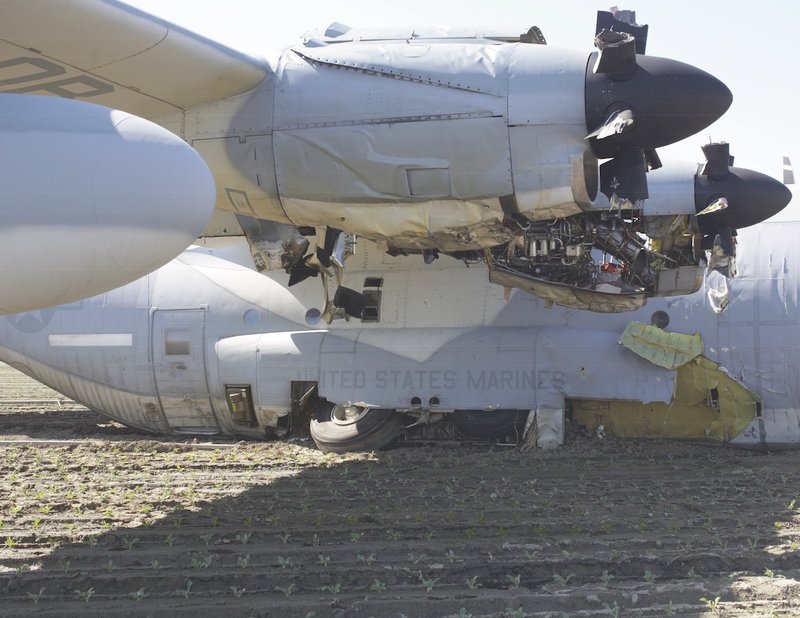
Raider 50 in a farm field near Thermal, California. The collision with Bolt 93 destroyed both engines and a fuel tank on the right wing along with the landing gear, visible sticking out of the plane. US Marine Corps photo.
THE PLANE SKIDDED FOR 300 YARDS, a soft, almost pleasant landing. After trading its last minutes of life for just enough flight time to save the crew, Raider 50 was dead.
Several doors wouldn’t open, and the crew had to kick their way through one that would. The plane had absorbed a final round of damage on the landing, as the good left wing dragged along the ground in the final yards, ripping off the refueling pod that the two F-35s had been forced to share. An endless waterfall of fuel poured out of the hole left behind.
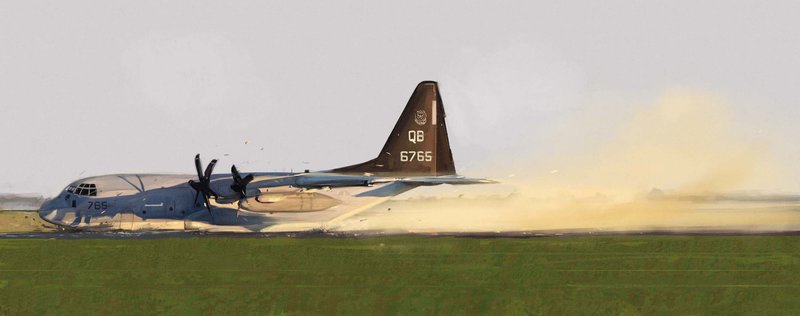
Illustration by Noah Regan.
“I still remember all the loadmasters coming up and shaking mine and Mike’s hands, and that was, you know, moving,” Jones said. “And then we just all couldn’t believe that we just walked away from that.”
Eventually a sheriff’s helicopter arrived, then police and firefighters and finally Marines from Miramar. Word spread that the pilot of Bolt 93 had ejected and parachuted safely. Over the next few weeks, the Marines took Raider 50 apart, piece by piece, trucking its wings and fuselage back to Miramar, then to the massive aviation boneyard at Davis-Monthan Air Force Base in Arizona.
But all that was still ahead as Jones bent over to speak with the two farmers who had asked him: Did you guys mean to do that?
Jones considered the question for a moment.
“No,” he replied. “We sure didn’t.”
This article first appeared in the Fall 2022 edition of Coffee or Die’s print magazine as “Raider Five Zero.”

Matt White is a former senior editor for Coffee or Die Magazine. He was a pararescueman in the Air Force and the Alaska Air National Guard for eight years and has more than a decade of experience in daily and magazine journalism.
BRCC and Bad Moon Print Press team up for an exclusive, limited-edition T-shirt design!
BRCC partners with Team Room Design for an exclusive T-shirt release!
Thirty Seconds Out has partnered with BRCC for an exclusive shirt design invoking the God of Winter.
Lucas O'Hara of Grizzly Forge has teamed up with BRCC for a badass, exclusive Shirt Club T-shirt design featuring his most popular knife and tiomahawk.
Coffee or Die sits down with one of the graphic designers behind Black Rifle Coffee's signature look and vibe.
Biden will award the Medal of Honor to a Vietnam War Army helicopter pilot who risked his life to save a reconnaissance team from almost certain death.
Ever wonder how much Jack Mandaville would f*ck sh*t up if he went back in time? The American Revolution didn't even see him coming.
A nearly 200-year-old West Point time capsule that at first appeared to yield little more than dust contains hidden treasure, the US Military Academy said.












